 Are you searching to learn more about Hitting Biomechanics? Then this is the article for you!
Are you searching to learn more about Hitting Biomechanics? Then this is the article for you!
Defining Exit Velocity: Hitting Biomechanics
Exit velocity (EV) refers to the speed at which a baseball leaves the bat immediately after a batter makes contact. This metric is a critical indicator of a hitter’s power and overall hitting performance. It has become a focal point in both college and professional baseball assessments due to its direct correlation with successful hitting outcomes. The higher the exit velocity, the harder and farther the ball is likely to travel, increasing the chances of extra-base hits and home runs. Consequently, EV is not just a number but a reflection of a hitter’s ability to generate power, control their swing, and make solid contact with the ball.
The measurement of exit velocity is typically done using advanced technologies such as radar guns and high-speed cameras, which capture the speed of the ball as it comes off the bat. This data is invaluable for coaches, scouts, and players as it provides a tangible measure of a player’s hitting potential and effectiveness. By analyzing EV, teams can identify hitters who possess the raw power needed to drive the ball effectively, making it a key component in player evaluations and development programs.
Importance of Exit Velocity: Hitting Biomechanics
Understanding and improving exit velocity is vital for players aiming to enhance their hitting capabilities. Higher exit velocities are often associated with superior hitting mechanics, greater muscle mass, and increased strength. These factors contribute to a player's overall performance and consistency at the plate. Players who can consistently achieve high exit velocities tend to have more success in producing hard-hit balls, which are more likely to result in base hits and extra-base hits.
Improving exit velocity involves a combination of physical training, technical adjustments, and strategic practice. Strength training plays a significant role, as greater muscle mass and strength allow hitters to generate more bat speed and power. Additionally, refining hitting mechanics to optimize the transfer of energy from the body to the bat can significantly impact EV. Techniques such as proper stance, weight transfer, and bat angle are all critical components that can enhance exit velocity.
For players at all levels, from high school to the major leagues, focusing on exit velocity can lead to substantial improvements in their offensive performance. Coaches and trainers use exit velocity metrics to tailor training programs that address specific needs, helping players to maximize their potential. As a result, exit velocity has become a fundamental aspect of modern baseball training and analytics, providing a clear and measurable goal for hitters to strive towards.
Comparing Biomechanics of Baseball Swings with Above and Below-Average Exit Velocities
 Study Overview: Hitting Biomechanics
Study Overview: Hitting Biomechanics
Ethan Harriel and Zachary Gillen from Mississippi State University conducted an insightful study to examine the differences in swing biomechanics between hitters with above and below-average exit velocities. This research aimed to understand how various physical and mechanical factors contribute to higher exit velocities, a crucial metric for evaluating hitting performance in baseball.
The study involved 87 male participants with varying skill levels, including high school, college, independent league, and minor league players. Advanced technology was used to gather detailed biomechanical data, including K-Motion hitting vests that track body movements and high-speed cameras that capture the intricacies of each swing.
Methods: Hitting Biomechanics
To conduct the study, each participant performed between four to nine swings. The swing with the highest exit velocity for each participant was selected for detailed analysis. The researchers calculated the average exit velocity across all participants, which was found to be 94.77 ± 6.20 mph. The participants were then divided into two groups: those with above-average exit velocities and those with below-average exit velocities.
The study compared several key metrics between these two groups, including:
- Body Mass and Height: Physical attributes that can influence the power and leverage a hitter can generate.
- Bat Weight and Length: Equipment factors that can affect the swing mechanics and the speed of the bat.
- Launch Angle: The angle at which the ball leaves the bat, which is crucial for determining the distance the ball travels.
- Velocities of Different Body Parts: This includes the speed of the bat, hands, upper arm, pelvis, torso, and center of gravity during the swing.
Key Findings: Hitting Biomechanics
 The study revealed several significant differences between hitters with above-average and below-average exit velocities. Key findings include:
The study revealed several significant differences between hitters with above-average and below-average exit velocities. Key findings include:
- Body Mass and Height: Hitters with above-average exit velocities generally had greater body mass (p < 0.001) and height (p = 0.017). This suggests that larger physical stature may provide an advantage in generating power during the swing.
- Bat Weight and Length: The above-average group used heavier (p = 0.001) and longer (p = 0.001) bats compared to the below-average group. This equipment choice likely contributes to higher swing speeds and greater impact force.
- Maximum Bat Speed and Hand Speed: The above-average group exhibited significantly faster bat speed (p < 0.001) and hand speed (p = 0.038). These factors are critical for increasing the speed at which the ball leaves the bat, directly impacting exit velocity.
These findings suggest that while good swing mechanics are essential, physical attributes such as muscle mass and strength play a critical role in achieving higher exit velocities. The study highlights the importance of a comprehensive approach to training that includes not only refining swing mechanics but also building physical strength and optimizing equipment choices.
Overall, this research underscores the multifaceted nature of hitting performance in baseball, emphasizing the need for tailored training programs that address both the physical and technical aspects of the game.
Harriel, E., & Gillen FACSM, Z. (2024). COMPARING BIOMECHANICS OF BASEBALL SWINGS WITH ABOVE AND BELOW-AVERAGE EXIT VELOCITIES. In International Journal of Exercise Science: Conference Proceedings (Vol. 16, No. 3, p. 305).
Types and Categories: Hitting Biomechanics
Classification by Skill Level: Hitting Biomechanics
- High School Hitters: Developing Fundamental Skills and Strength: High school hitters are typically in the early stages of their baseball careers, focusing on developing fundamental skills and building overall strength. At this level, players work on refining their batting stance, grip, and swing mechanics. They are also introduced to strength training programs that aim to enhance their muscle mass and power, laying the foundation for more advanced techniques as they progress. Coaches emphasize proper form and consistency to help these young athletes develop a solid hitting base.
- College Hitters: More Refined Mechanics and Increased Muscle Mass: College hitters have usually mastered the basics and are now working on refining their swing mechanics and increasing their muscle mass. At this stage, players engage in more specialized training programs tailored to their specific needs. Strength and conditioning routines become more rigorous, focusing on enhancing overall power and bat speed. These athletes also receive advanced coaching on pitch recognition, timing, and situational hitting, helping them become more versatile and effective at the plate.
- Independent League Hitters: Advanced Mechanics with Focus on Optimizing Power: Hitters in independent leagues possess advanced mechanics and are focused on optimizing their power and overall performance. These players have typically been through college programs or have professional experience, and they bring a high level of skill to their hitting. Training at this level includes sophisticated biomechanical analysis to fine-tune swing efficiency and maximize exit velocity. Strength training continues to be a significant component, with an emphasis on maintaining peak physical condition to support their hitting capabilities.
- Minor League Hitters: High-Level Skill with Significant Muscle Mass and Strength: Minor league hitters are on the cusp of reaching the major leagues, displaying high-level skill, significant muscle mass, and strength. These players are often the product of years of intensive training and development. Their focus is on perfecting every aspect of their swing mechanics and maintaining peak physical fitness. They engage in highly specialized training regimens that include advanced strength and conditioning programs, nutritional plans, and mental conditioning to ensure they are prepared for the demands of professional baseball.
Classification by Performance: Hitting Biomechanics
- Above-Average EV Hitters: Stronger, Use Larger Bats, and Have Faster Bat and Hand Speeds: Hitters with above-average exit velocities are typically stronger, with greater muscle mass and physical stature. They tend to use larger and heavier bats, which, combined with their strength, allows them to generate higher bat and hand speeds. These players often display superior swing mechanics, enabling them to make solid and powerful contact with the ball consistently. Their training regimens are focused on maintaining and enhancing their strength, power, and technical skills to keep their performance at an elite level.
- Below-Average EV Hitters: Often Smaller in Stature with Less Muscle Mass and Slower Swing Speeds: Hitters with below-average exit velocities are often smaller in stature and have less muscle mass compared to their above-average counterparts. As a result, they tend to use lighter and shorter bats, and their bat and hand speeds are generally slower. These players may still have good hitting mechanics, but their physical limitations impact their ability to generate high exit velocities. Their training focus often includes increasing muscle mass and improving swing speed, along with refining their technique to maximize their hitting potential within their physical constraints.
Hitting Biomechanics
Introduction to GFT Hitting Program
The Ground Force Torque (GFT) Hitting Program is designed to maximize a hitter's power and efficiency by focusing on the biomechanics of the swing. This program utilizes a two-phase hitting approach and incorporates detailed mechanics to ensure optimal performance. The GFT Hitting Program combines scientific principles with practical drills to help hitters develop elite-level skills.
The Two-Phase Hitting Mechanics
Ground Force Phase
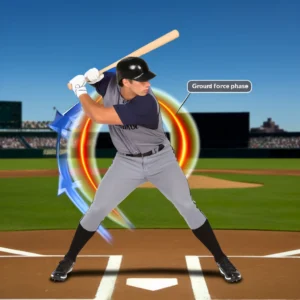 The Ground Force Phase is the initial stage of the swing, where the hitter generates power from the lower body. This phase begins when the front foot lifts off the ground, shifting the weight onto the back leg, and ends when the front foot plants back down. During this phase, the hitter creates ground force through the legs and hips, which is critical for generating bat speed and power.
The Ground Force Phase is the initial stage of the swing, where the hitter generates power from the lower body. This phase begins when the front foot lifts off the ground, shifting the weight onto the back leg, and ends when the front foot plants back down. During this phase, the hitter creates ground force through the legs and hips, which is critical for generating bat speed and power.
Key Elements of the Ground Force Phase:
- Back Leg Loading: The back leg must be properly loaded to generate maximum force. The hitter starts by placing the foot parallel to the front of the plate, with about 60% of the body weight on the back leg. The back leg should be flexed at the knee and ankle, creating torsion and building potential energy.
- Front Leg Timing: As the front foot plants, it stabilizes the body, allowing the hips to rotate and transfer energy. The front leg should be slightly flexed and positioned to support the rotational movement of the hips.
- Rotation and Extension: The back leg drives the rotation of the hips, while the front leg extends to maximize hip rotation. This movement creates a powerful torsion force, essential for transferring energy from the lower body to the upper body.
Contact Phase
 The Contact Phase begins when the front foot plants and the hips start to rotate. This phase focuses on transferring the energy generated in the Ground Force Phase through the upper body to the bat, ensuring precise and powerful contact with the ball.
The Contact Phase begins when the front foot plants and the hips start to rotate. This phase focuses on transferring the energy generated in the Ground Force Phase through the upper body to the bat, ensuring precise and powerful contact with the ball.
Key Elements of the Contact Phase:
- Separation Power: This involves creating tension between the back hip and back shoulder, similar to stretching a rubber band. The back hip drives towards the pitch while the back shoulder holds back, building tension that releases explosively to power the swing.
- Upper Body Sequencing: Proper sequencing of the upper body is crucial for maintaining power and precision. The back elbow engages with the hip, guiding the bat through a linear path. The trunk and arms work together to ensure the bat stays in the same plane as the ball, maximizing the probability of solid contact.
- Barrel Control: Maintaining a linear bat path through the zone is essential for consistent contact. The bottom hand arm guides the bat, while the top hand elbow stays engaged with the back hip to transfer energy efficiently.
Basic Mechanics of the GFT Hitting Program
 Back Leg Loading: Proper back leg loading sets the foundation for a powerful swing. The hitter must place the back foot parallel to the front of the plate, with the hips and shoulders aligned with the pitcher. The back leg should be flexed, with the weight shifted onto the back leg. This position builds torsion in the leg, preparing it to drive rotation and generate force.
Back Leg Loading: Proper back leg loading sets the foundation for a powerful swing. The hitter must place the back foot parallel to the front of the plate, with the hips and shoulders aligned with the pitcher. The back leg should be flexed, with the weight shifted onto the back leg. This position builds torsion in the leg, preparing it to drive rotation and generate force.- Front Leg Timing: Timing the front leg's movement is critical for stabilizing the swing and maximizing hip rotation. As the hitter shifts weight from the back leg to the front leg, the front leg must stabilize and support the rotational energy. The front leg should be slightly bent and positioned to drive the hips open, ensuring a smooth and powerful transfer of energy.
- Bat Loading: The bat load prepares the upper body for the swing. The hitter should maintain a neutral grip with both hands, ensuring the wrists are not bent. The back elbow should be positioned behind the body, with the scapula pinched and loaded. As the hips drive towards the pitch, the back arm engages with the back hip, loading the bat and building centrifugal force for the swing.
- Lower Body Sequencing: Effective lower body sequencing is essential for transferring energy from the legs to the upper body. The back leg starts the sequence by generating ground force, which drives the hips to rotate. The front leg stabilizes and supports this rotation, creating a solid foundation for the upper body to generate power.
- Separation Power: Separation power involves creating tension between the back hip and back shoulder. This tension, similar to a stretched rubber band, releases explosively to drive the swing. Proper timing and sequencing of the back leg and front leg force production are critical for maximizing hip rotation and shoulder acceleration.
- Upper Body Sequencing: Upper body sequencing ensures the efficient transfer of energy from the lower body to the bat. The back elbow engages with the hip, guiding the bat through a linear path. The trunk pulls back to accelerate the arms, ensuring the bat stays in the same plane as the ball for optimal contact.
Practical Application with GFT Hitting Drills
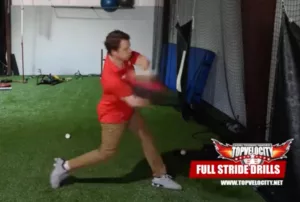 The GFT Hitting Program includes a series of drills designed to reinforce these mechanics. Each drill focuses on specific aspects of the swing, helping hitters to develop a powerful and efficient hitting technique.
The GFT Hitting Program includes a series of drills designed to reinforce these mechanics. Each drill focuses on specific aspects of the swing, helping hitters to develop a powerful and efficient hitting technique.
Example Drill: Linear Momentum Drill
- Setup: Position the back leg completely internally rotated, with the back hip pushing ahead of the back shoulder. The front leg should be in a full stride position, slightly closed to the pitcher.
- Execution: Start by lifting the front leg and driving the back hip forward. Plant the front foot and stabilize, allowing the back hip to drive forward and create tension between the back hip and shoulder. Engage the back elbow with the hip and guide the bat through a linear path into the strike zone.
- Focus: Emphasize stabilizing the front leg and extending it to accelerate trunk rotation. Ensure the back elbow stays engaged with the hip to transfer energy efficiently.
By incorporating these drills and focusing on the key mechanics outlined in the GFT Hitting Program, hitters can develop a powerful, efficient swing that maximizes exit velocity and overall hitting performance.
Enhance Your Bat Speed with the GFT Hitting Program
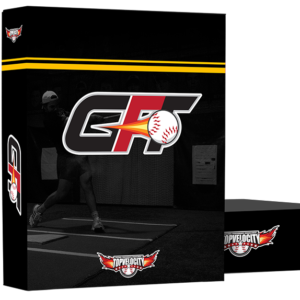 Are you ready to take your hitting performance to the next level? The GFT Hitting Program by TopVelocity is designed to help you maximize your bat speed, power, and overall hitting efficiency. Whether you're a high school player looking to improve your fundamentals or a seasoned athlete aiming for elite performance, the GFT Hitting Program has the tools and techniques you need.
Are you ready to take your hitting performance to the next level? The GFT Hitting Program by TopVelocity is designed to help you maximize your bat speed, power, and overall hitting efficiency. Whether you're a high school player looking to improve your fundamentals or a seasoned athlete aiming for elite performance, the GFT Hitting Program has the tools and techniques you need.
This comprehensive program, built on scientific principles and advanced biomechanics, offers a two-phase hitting approach that focuses on generating ground force and optimizing contact. With detailed mechanics and specialized drills, you'll learn how to harness your full potential and make consistent, powerful contact with the ball.
Don't miss this opportunity to elevate your game. Invest in the GFT Hitting Program today and start seeing real improvements in your bat speed and hitting performance. Visit TopVelocity.net/gft to purchase the program and begin your journey to becoming a more powerful and effective hitter.
Get Started Now!
Transform your hitting mechanics and boost your bat speed with the proven methods of the GFT Hitting Program. Join the ranks of elite hitters who have achieved outstanding results with TopVelocity. Click the link below to learn more and purchase the GFT Hitting Program:
Unleash your potential and dominate at the plate with TopVelocity's GFT Hitting Program!
For more exclusive content visit the TopVelocity Patreon!


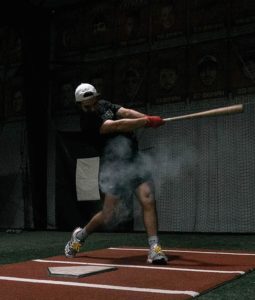 Study Overview: Hitting Biomechanics
Study Overview: Hitting Biomechanics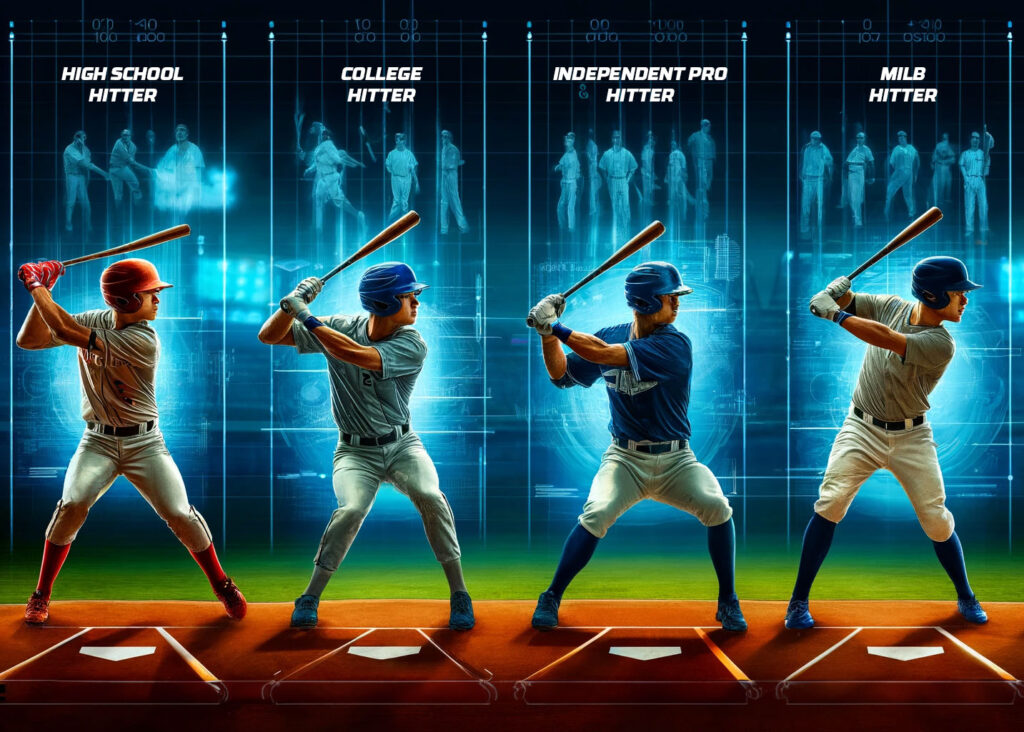
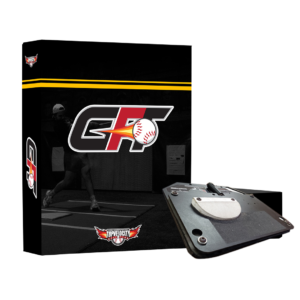 Back Leg Loading: Proper back leg loading sets the foundation for a powerful swing. The hitter must place the back foot parallel to the front of the plate, with the hips and shoulders aligned with the pitcher. The back leg should be flexed, with the weight shifted onto the back leg. This position builds torsion in the leg, preparing it to drive rotation and generate force.
Back Leg Loading: Proper back leg loading sets the foundation for a powerful swing. The hitter must place the back foot parallel to the front of the plate, with the hips and shoulders aligned with the pitcher. The back leg should be flexed, with the weight shifted onto the back leg. This position builds torsion in the leg, preparing it to drive rotation and generate force.


Trackbacks/Pingbacks